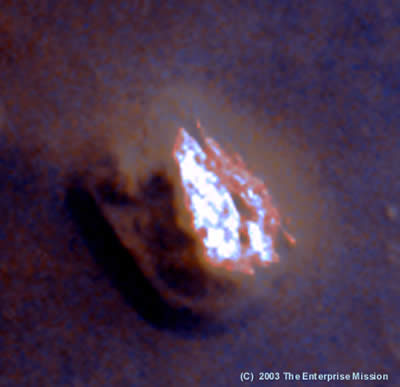 | |
| The Light Finally Dawns at Cydonia …. | |
| By Richard C.
Hoagland © 2003 The Enterprise Mission | |
This startling new
image of the well-known "Face on Mars" (above) may ultimately be regarded
as one of the most important photographs of the entire Space Program. For,
after almost 30 years of acrid controversy and debate, a "whole new side"
to this perplexing Martian mystery - and the profound social and
scientific questions it continues to present - has now literally dawned
….
The image above is an enhanced, color close-up created by Keith Laney and the Enterprise Mission - from a combination of three 2001 Mars Odyssey VIS frames (of the five simultaneously taken by the Odyssey VIS camera system). The official image release is JPL/ASU V0 3814003 (below). The five frames - from the near "IR" end of the visible spectrum, to the "violet" -- were acquired by the Odyssey spacecraft as it flew over the Cydonia region on October 24, 2002 -- precisely one year (Greenwich time) after Odyssey arrived in Martian orbit.
What makes this color close-up so remarkable is that, for the first time in over a generation, a NASA spacecraft acquired multi-spectral images of "the Face" as seen in morning light - with the illumination coming from the East. What this unique sun angle has now revealed - a Cydonia view that researchers had yearned for, but never before had the opportunity to analyze -- is nothing less than revolutionary ….
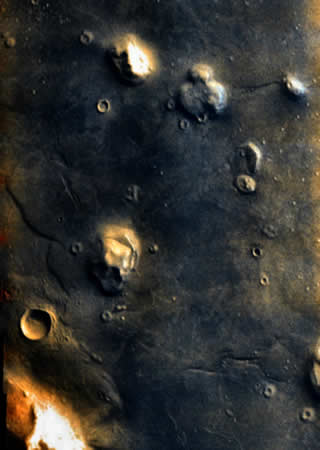 |
| For, even casual examination of the Face as seen in this "new light" (above, top) reveals two new pieces of vital information: 1) that the eastern side, under even this pre-dawn illumination -- for whatever reason -- is incredibly reflective; and 2) that, in lowered contrast images (below) the source of this anomalously "high albedo" is an inexplicable series (in the natural model) of highly geometric "panels!" |
| Even those of us who, for some time now, have interpreted the
weight of evidence in favor of an artificial
origin for this unique Cydonia construct, this new data is
unexpected - nay, startling -- confirmation of our previous
analysis.
The key parameter that makes this new image so remarkable, is "when" it was acquired. If you carefully examine the "data block" for image V0 3814003 on the Arizona State University (ASU) THEMIS website (above), you can immediately ascertain that it was taken by the Odyssey camera "at 4:39 AM," local Martian time. Further reading of the table reveals that the "phase angle" - that is, the geometric relationship between the Sun, the Martian surface directly underneath the spacecraft just east of the Face, and Odyssey itself - was "90.3 degrees." Since "90 degrees" (for a spacecraft directly overhead) would indicate the Sun was literally on the eastern horizon, the slightly greater angle reveals that actually the sun was 0.3 degrees below the horizon when the image was acquired (and even slightly lower at the location of Face itself). The last line in the table, "Description: Cydonia - face at night" confirms this geometry: technically, then, this "Odyssey dawn image" was actually acquired just before sunrise … with the Sun still hidden below the Cydonia horizon (below). |
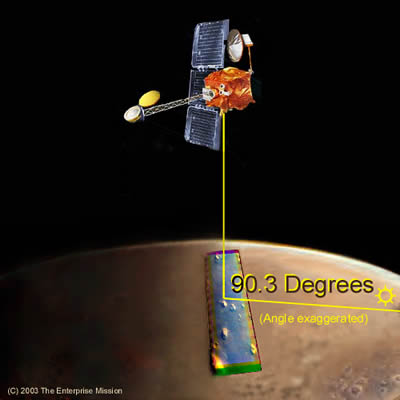 |
| This simple, inarguable geometry makes the astonishing high
brightness of the Face's eastern side - and before the Sun has risen
- extraordinary …. And this, in turn, leads directly to the pivotal
question: just what could make "an average Martian mesa" (to quote
Carl Sagan, from his infamous Parade Magazine "Cydonia hit piece"
many years ago) so incredibly reflective … even in the semi-dark,
pre-dawn twilight of Cydonia?
* * * A side-by-side comparison (below) reveals the true incongruity of such a brilliant-surfaced object. The official NASA version of the Face from V03814003 (left) is totally "washed out" on the illuminated (eastern side) - even though the image was shot before the sun had risen!; while, in the Enterprise rendition (right), after considerable effort to lower brightness levels, some surface details can just be seen beneath the glare. Again, for this over saturation of the THEMIS imaging CCDs to have occurred, and under these really dim lighting conditions, "something" about the innate reflectivity of this Martian surface feature -- at this geometry -- must truly be "anomalous." To learn |
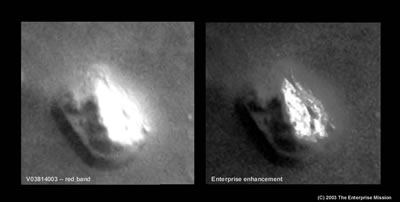 |
| just how "anomalous," one only need look to spacecraft surface images of pre-dawn Martian twilight, captured by other unmanned missions … for instance, the unmanned Viking Landers in 1976 (below) or Pathfinder, in 1997. |
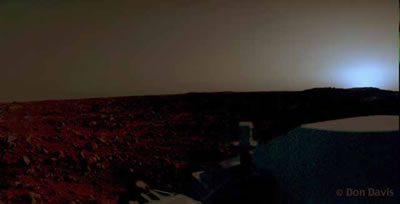 |
| In this Viking 1 post-sunset surface view (above), prepared
by former USGS graphic artist Don Davis, note how the sky remains
bright well after the sun sets on Mars (sunset, of course, is merely
the opposite condition to sunrise; therefore a post sunset image is
optically equivalent to a pre-dawn image at the same location and
time) The bluish "afterglow" several degrees above the sunset point
on Mars is due to the unique "forward scattering" properties of the
much thinner Martian atmosphere, which is filled with varying
amounts of finely-divided dust (in the official model) -
preferentially scatteing blue light forward toward the camera ….
The major thing to note in this image is the Lander wind cover on the Viking nuclear power generator (light ellipse -- far right): notice that it is just barely visible in this twilight Mars illumination … even though the lighting geometry is ideal for so-called "specular reflection" (the light above the setting sun should be bouncing directly toward the camera) and … the cover itself is painted brilliant white! Yet, as can be seen, under this illumination this white wind cover is barely noticeable! Why, under identical lighting (below), is the Face- even allowing for the obviously increased gain settings in the Odyssey camera (to bring out the darker western side) -- so incredibly bright? And why is that inexplicably reflective eastern surface also arrayed in those stark … startlingly geometric … patterns? |
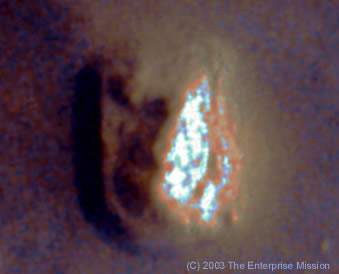 |
| Another pre-dawn image (below), this one from Mars Pathfinder, reinforces this enigma: an obviously almost un-illuminated landscape, lit only by the sky, clearly incapable of presenting such dramatic surface differences as seen in the Odyssey Cydonia image …. |
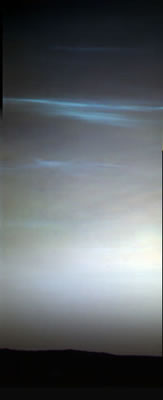 |
| But it's a Viking 2 sunrise shot that best illustrates this major new Cydonia mystery. |
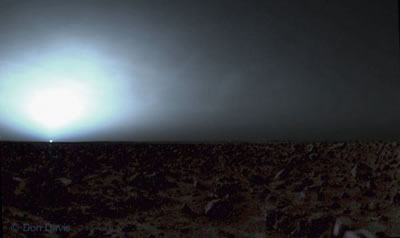 |
| As you can see (above), even with the sun actually on the horizon, the overall illumination of the surface landscape in this Viking 2 dawn image is extremely dark -- a combination of dust absorption of sunlight at the horizon, and an extremely thin Martian atmosphere. |
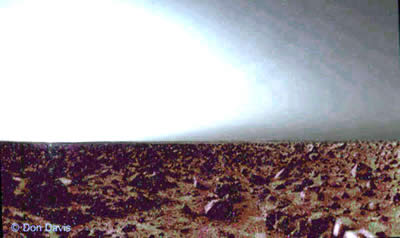 |
| With the gamma of the same image significantly increased
(above) - equivalent to the gain employed in the Odyssey VIS camera
for the pre-dawn Cydonia image -- the surface rocks and other
features become more visible. But, as is readily apparent, with the
exception of two small foreground objects at the lower right,
brightness extremes presented by the Face are simply not present on
the reddish rocks and boulders strewn across this Martian landscape
- even when directly illuminated by the rising sun!
The exceptions (below) are in themselves most interesting. It is apparent that their bright sunward-facing surfaces are from polished, mirror-like reflections - probably caused by wind blown sand abrading over time metallic crystal surfaces (or, at least "something" metallic …). |
 |
| The problem with applying this natural explanation to the
Face is simply this:
The specular reflections from these close-in features viewed by the Viking 2 camera are on the order of "a few square inches"; the surface area of specular reflections from the Face's eastern side measures several miles in area … Further contrast enhancement and brightness reduction of the Face on image V03814003 (below), seeking to penetrate the last, still overexposed highlights of this incredibly reflective surface, reveals an astonishing continuation of the "grid-like geometry" noted earlier. This, in turn, is strikingly consistent with a critical prediction, regarding the possibly highly anomalous physical nature of this surface … made over ten years ago. |
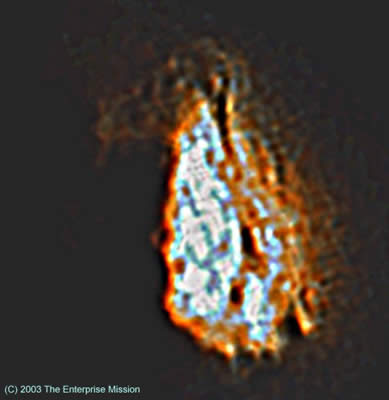 |
| Beginning in the 1992 Edition of "The
Monuments of Mars," we strongly suggested that the Face was NOT
merely "a mesa-carved 'Mount Rushmore' … lying on a level Martian
plain" -- but something "far more interesting."
Mark Carlotto and Mike Stein's unprecedented computerized fractal work on the original Viking images had strongly indicated by 1990 that "something" about the Face was decidedly "non-fractal" -- i.e. in one interpretation, it is composed of artificial surface materials (see below), which are successfully resisting the relentless efforts of the Martian climate to turn them back to dust. The bright "Face highlight" of the non-fractal Face image (left) indicates how much it departs from its far more fractal surroundings …. |